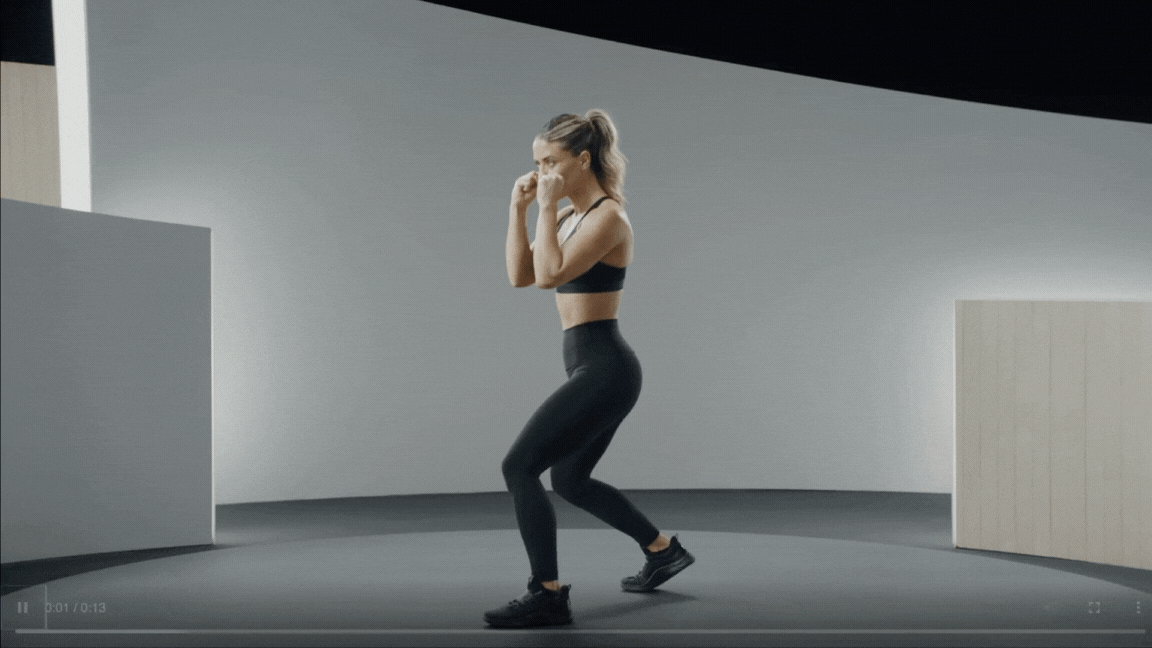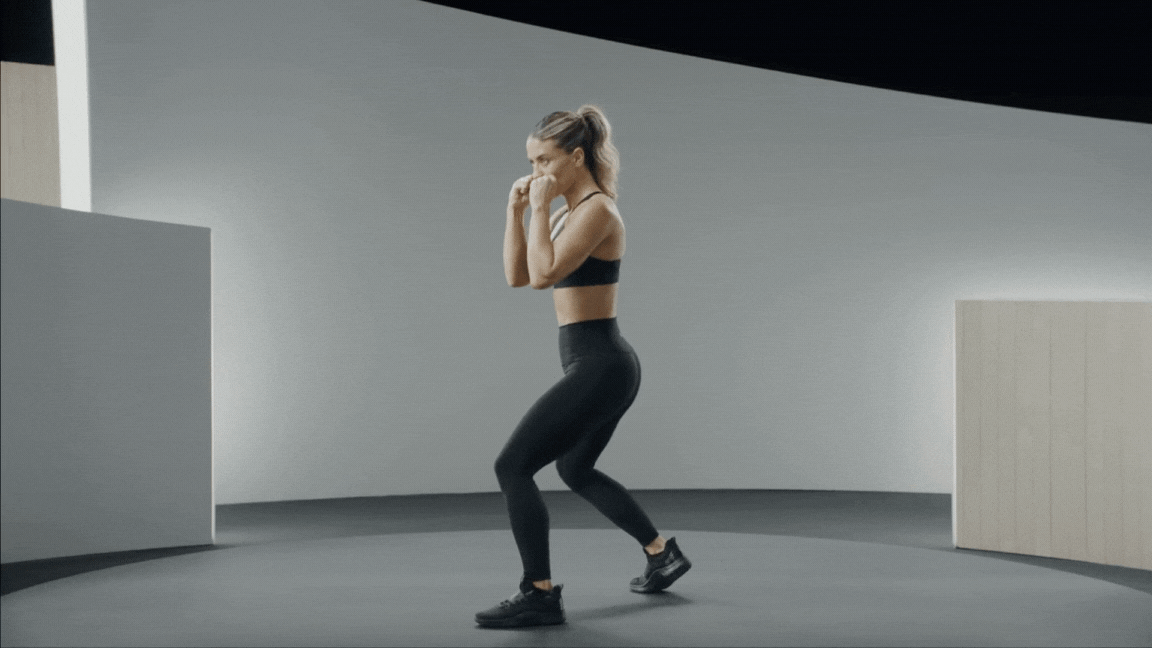
How to Make Your Uppercut Punch More Powerful Than Ever
Uppercuts may be a basic boxing move, but throwing one with good form is no easy feat.
By Lauren Mazzo•
What Is an Uppercut Punch In Boxing?
How to Correctly Throw an Uppercut Punch
Uppercut Variations
Common Mistakes to Avoid for Uppercuts
Uppercut Benefits
Takeaway
If you’ve never tried boxing or another martial art, you might think there’s just one basic way to throw a punch: straight out in front of you. But there are actually six foundational punches you’ll learn when you start to box: the jab, cross, front hook, back hook, front uppercut, and back uppercut.
They all have their strengths, but uppercuts can be particularly potent if you’re fighting an opponent. “The uppercut comes from a different angle than the other punches,” explains Peloton instructor Rad Lopez. “Generally speaking, the straights (jab, cross) are thrown directly forward, the hooks are thrown to land on the sides, and the uppercut comes from beneath the eye level of your target/opponent, making it harder to detect if through sharply and correctly and of course, in the right situation.”
If you’re less concerned with tearing down an opponent and more with building yourself up, the uppercut has plenty of benefits for you, too. Even if you’re just shadowboxing (punching the air) or punching a bag, doing uppercuts for reps and as part of more complex punch combinations can seriously fortify your body and brain. Ready to get punching? Everything to know about uppercuts, ahead.
What Is an Uppercut Punch In Boxing?
You’ll find the uppercut punch in boxing and other combat sports, such as mixed martial arts. “This punch is thrown with a rising motion aimed at an opponent's chin, jaw, or body,” Rad explains. You can perform both lead (front) uppercuts and rear (back) uppercuts with your front hand and back hands, respectively. (For example, if you’re a right-handed striker, your lead uppercut will be with your left hand, and your rear uppercut will be with your right hand.)
“Uppercuts are often executed after other punches as part of a combination,” says Tony Ricci, scientific advisory board member for the National Academy of Sports Medicine (NASM) and lead subject matter expert for NASM's MMA Conditioning Specialist program.
How to Correctly Throw an Uppercut Punch
In general, when you’re throwing an uppercut, Rad says you want to think about a few key things: your body rotating as you extend your arm at a 90-degree angle with your palm facing you, and simultaneously driving your knuckles up and into the target. “Normally you want to envision the punch landing beneath the chin or into the body.”
Here’s how to build an uppercut from the ground up, according to Rad and Ricci.
First, Find Your Boxing Stance
“An uppercut can be thrown from numerous positions,” Ricci says, but generally, most strikes come from the classic boxing stance: Stand with your feet shoulder-width apart. If you’re right-handed, take a big step backward with your right foot, and do the opposite if you’re left-handed. (Either way, make sure your feet are still about shoulder-width apart.) Turn your feet so your toes are pointing slightly toward your dominant side. Your hips and shoulders should be squared, pointing straight toward your target. Bring your fists up below your chin to guard either side of your face, keeping your elbows close to your body. This is your ready position.

How to Throw a Front Uppercut
Start in ready position with your fists guarding either side of your face. Keep your elbows close to your body, and your knees softly bent.
Transfer your weight slightly into your front leg, lifting your rear heel off the floor. Bend your knees slightly to generate power, and drop your front arm, bent at about 90 degrees, and palm facing up. (Keep your other hand where it is, protecting your face.)
Keeping your core engaged, think about driving your feet into the floor, rotating your hips to the right, and swinging your bent punching arm up in an arching motion (with your palm facing toward you and your arm stiff) as if you were hitting your opponent on the bottom of the chin.
Immediately pull your punching hand back to guard your face, and return your hips and feet to a neutral boxing stance.

How to Throw a Back Uppercut
Start in ready position with your fists guarding either side of your face. Keep your elbows close to your body, and your knees softly bent.
Transfer your weight slightly into your front leg, lifting your rear heel off the floor. Bend your knees slightly to generate power, and drop your rear arm bent at about 90 degrees and palm facing up. (Keep your other hand where it is, protecting your face.)
Keeping your core engaged, drive the right heel up to quickly rotate your rear foot, knee, hips, and shoulders toward your opponent. Bring your rear arm with you, swinging it in an arching motion up and forward (with your palm facing you and your arm stiff) as if you were hitting your opponent on the bottom of the chin.
Immediately pull your punching hand back to guard your face, and return your hips and feet to a neutral boxing stance.
To generate effective punches, you want to think of all your power coming from the floor. Energy must be transferred through the body’s kinetic chain, starting with the ground reaction force (the force the floor exerts on a body in contact with it), Ricci explains. As you do an uppercut, the force from the ground travels up your leg, through your core, into your shoulder, and out your hand at the point of (theoretical) impact.
Uppercut Variations
If you want to play with uppercuts specifically, you can spice things up in a few different ways. For example, you can change the strike target (i.e., the head or different regions on the body), as well as differing angles from which it’s thrown, Ricci says.
You can also increase the difficulty by adding external resistance. “Use hand weights to add more resistance to your punches, ankle weights to challenge your footwork, and or a weighted vest to challenge the resistance behind your movements,” Rad suggests.
Keep in mind you should dial in your form before trying anything fancy. “The uppercut, like all punches, requires systematic muscular coordination and superb timing for proper execution, so mastering this technique first is highly advisable,” Ricci says.
Common Mistakes to Avoid for Uppercuts
The biggest mistake people make when doing uppercuts (or any punch, for that matter), is throwing it without proper use of the foot, hip, core, and shoulder rotation, Ricci says. “Punching without using the hips and core and swinging largely from the arm is a common mistake in all strikes. Not only does this significantly reduce power, but it can also put strain on the shoulder and arm and potentially lead to injury.”
A close second is the mistake of dropping your guard, he adds. If you let the non-punching hand drop, you’re leaving yourself open for a counterpunch from your opponent.
Finally, many athletes will close or open the elbow too much. Generally, the elbow and hand must be aligned during the strike, in a 90-degree angle. “Not only will you lose power if the elbow and hand are not aligned, but it can injure the shoulder, elbow, and/or hand,” Ricci says.
Uppercut Benefits
Boxing, in general, comes with some incredible mind-body benefits. “Boxing and striking adds complex cognitive and motor skill demands to a workout, which not only builds cardiovascular and local muscle endurance, but builds excellent balance, coordination, and kinesthesia (body space awareness),” Ricci says. Research also suggests that non-contact boxing training can have a cascade of positive effects on mental health, including releasing anger and stress and improving mood, self-esteem, confidence, and concentration.
Learning to do uppercuts, specifically, helps you add variety to your combos and understand where the punches are meant to land and the strategy behind them. “Boxing is a game much like chess, where keeping your opponent guessing your next move is key, thus variety being a very important part of the game,” Rad says.
If you’re wondering which muscles are worked in an uppercut, the answer is, honestly, most of them. Remember how the power of a punch starts in the floor and transfers through the body’s kinetic chain? Every muscle hit in that journey is activated to a certain degree. For example, the reactionary forces are transmitted first through the lower leg, including the ankle complex and gastrocnemius (calf), Ricci explains. Then it moves through the upper legs, including the quadriceps, adductors, and gluteus maximus, and then the pelvis, which contributes to much of the rotation and angular velocity required to throw the punch, he says. That will further transmit force through the core—the transverse abdominis (deep core muscles), internal and external obliques, serratus anterior (a fan-shaped muscle on the side of your ribs), and multifidus muscles along the spine. Finally, it goes through to the shoulder complex: the anterior and medial deltoid (shoulder muscles) and, to an extent, the lats and muscles of the rotator cuff, Ricci says.
Takeaway
Uppercuts are a must-know punch if you’re learning to box, and they’re a pretty powerful one, at that. That said, they don’t work best alone but in combination with other essential boxing moves. “By adding additional punches to the uppercut, you’re engaging in a challenging mental and physical training session,” Ricci says, “and one that can be very fun.”

Peloton App
Access thousands of classes with no equipment needed.
This content is for informational and educational purposes only and does not constitute individualized advice. It is not intended to replace professional medical evaluation, diagnosis, or treatment. Seek the advice of your physician for questions you may have regarding your health or a medical condition. If you are having a medical emergency, call your physician or 911 immediately.
Level up your inbox.
Subscribe for a weekly dose of fitness, plus the latest promos, launches, and events.
By providing your email address, you agree to receive marketing communications from Peloton.
For more about how we use your information, see our Privacy Policy.






